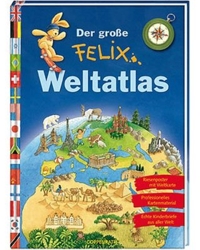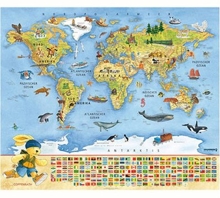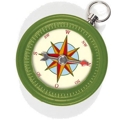|
Felix explains the World
 Why do we have days and nights? How do you make maps and how do you read them? What does everyday life in other countries look like? Der große Felix-Weltatlas provides answers to questions like these. In addition to highly detailed maps primary school pupils are provided with scientific facts on the origins of Earth, the space, seasons, climate or time zones and different species. The clou: Children from all over the world have contributed letters describing everyday life in Ireland, Ghana or Afghanistan. And an Antarctic scientist tells about life in a research centre at minus 40 degree Celsius. But there's even more: the book also tackles hot topics like climate change, environment protection and population development and gives children food for thought. The book arouses curiosity about the big, wide world in little explorers - and the included compass lets children catch the travel bug. Why do we have days and nights? How do you make maps and how do you read them? What does everyday life in other countries look like? Der große Felix-Weltatlas provides answers to questions like these. In addition to highly detailed maps primary school pupils are provided with scientific facts on the origins of Earth, the space, seasons, climate or time zones and different species. The clou: Children from all over the world have contributed letters describing everyday life in Ireland, Ghana or Afghanistan. And an Antarctic scientist tells about life in a research centre at minus 40 degree Celsius. But there's even more: the book also tackles hot topics like climate change, environment protection and population development and gives children food for thought. The book arouses curiosity about the big, wide world in little explorers - and the included compass lets children catch the travel bug.
 “A perfect introduction to the fascinating world of geography!” says Prof. Dr. Dr. h. c. Manfred Domrös, Director Institute of Geography at the University of Mainz. Complex information on the origins of Earth, the space, seasons, climate or time zones and the professional maps have been revised and complemented with many details and extras in cooperation with globe manufacturer Columbus. A giant world map poster with all national flags tops off the atlas and makes facts easier to understand - a real eye catcher for every child's room or even in class. “A perfect introduction to the fascinating world of geography!” says Prof. Dr. Dr. h. c. Manfred Domrös, Director Institute of Geography at the University of Mainz. Complex information on the origins of Earth, the space, seasons, climate or time zones and the professional maps have been revised and complemented with many details and extras in cooperation with globe manufacturer Columbus. A giant world map poster with all national flags tops off the atlas and makes facts easier to understand - a real eye catcher for every child's room or even in class.
Not only the highly detailed maps are remarkable – also the layout is very special. A large unfoldable page shows different panoramas and describes the origins of rivers, mountains and different animal and plant species. An extra booklet supplies inquisitive minds with more information about Germany, Austria and Switzerland. A real compass and a giant world map poster with all national flags top off the atlas and arouse the curiosity of future explorers.
 "The world in a village” is the headline of a chapter that graphically explains world population: "If you could shrink the Earth with its population of 6 billion people to the size of a village with 100 inhabitants, 57 people would have been Asians, 21 Europeans, 13 Americans, only eight from Africa and just one Australian – according to statistics.” "The world in a village” is the headline of a chapter that graphically explains world population: "If you could shrink the Earth with its population of 6 billion people to the size of a village with 100 inhabitants, 57 people would have been Asians, 21 Europeans, 13 Americans, only eight from Africa and just one Australian – according to statistics.”
This is a book that will accompany inquisitive children for many, many years. Even preschool children love to flip through the colourful pages, although they still are not able to read: There are so many details to be discovered at the maps and pictures! … And when they have finally learnt to read the texts, a whole new world opens up for them. The carefully designed atlas will soon belong to those books that never really leave the child’s room and are taken down the shelves again and again. And even adults appreciate this treasury of information.
In the end it’s "To the Future". Authoress Annette Langen shows her little readers how they can take action and how all of us can take better care of our planet. And so her last wish is: "Look after yourself and our Earth, because both of you are unique!”
| 


